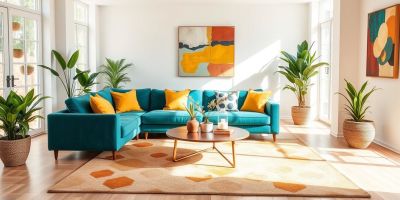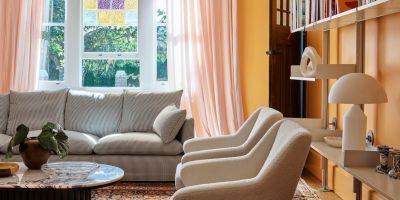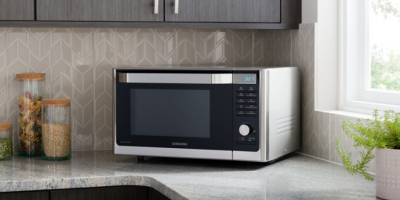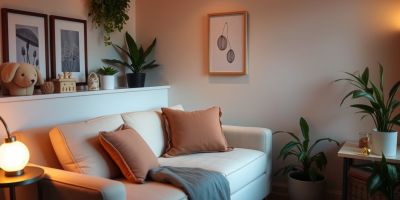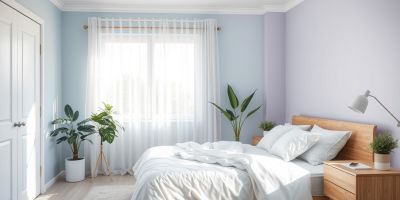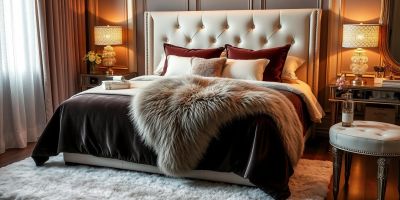2024-12-03 11:55:49 |
Choosing the right colour for your bedroom is a fun journey of self-expression. Unlike other rooms, bedroom colours let you create a personal space that shows your style and helps you relax. With so many options, picking the perfect colour can be both thrilling and challenging.
Marianne Shillingford, Dulux's creative director, suggests a versatile colour palette. This way, you can change your bedding and accessories without repainting the whole room. Whether you like calm neutrals, bold walls, or soft pastels, the right colours can make your room feel amazing.
There are countless options for bedroom colours, from rich darks to warm earth tones. As we look at different colours, remember the right shade should look good and make your room a place for rest and refreshment.
Key Takeaways
- Bedroom colours are a personal choice with fewer practical constraints
- Versatile palettes allow for easy updates as tastes change
- Colour psychology plays a significant role in bedroom design
- Popular choices include blush pink, dark green, and midnight blue
- Warm neutrals and pastels create relaxing bedroom schemes
- Colour can dramatically impact sleep quality and mood
Understanding Colour Psychology in Bedroom Design
Colour psychology in bedrooms is key to relaxation and good sleep. The colours we pick can greatly affect our mood and health.
How Colours Affect Sleep and Mood
Cool colours like blue, green, and sapphire calm us down. They can lower blood pressure and reduce anxiety. This makes them great for bedrooms. Warm colours, such as soft pink, peach, and beige, make a room feel cosy but not too bright.
Creating Balance Through Colour Selection
Neutral colours like grey and cream are versatile in bedroom design. They fit well with different styles and moods, creating a balanced look. Soft shades of pale blue, gentle green, and warm neutrals bring peace, ideal for a calm space.
The Science Behind Relaxing Bedroom Colours
Studies show colours can affect our body's functions. Blue, for example, can lower blood pressure and heart rate. On the other hand, red can raise heart rate, making it less calming for bedrooms. Colour meanings also vary across cultures. In Egypt, yellow is seen as joyful by only 5.7%, while in Finland, it's 87.7%.
When picking calming colours for your bedroom, add textiles to enhance the look. Mixing fabrics like cotton, linen, and wool adds comfort and a rich feel. This complements the soothing colours you've chosen.
Bedroom Colour Ideas for Ultimate Tranquility
Choosing the right colour palette is key to a peaceful bedroom. Soft, muted tones can turn your space into a calm retreat. Let's look at some calming colour schemes that help you relax and sleep better.
For a calm vibe, think about paint colours like Balboa Mist 1549 by Benjamin Moore or Rain Cloud by Sherwin-Williams. These soft hues make a soothing background for your bedroom. If you like warmer tones, Setting Plaster by Farrow amp; Ball is a gentle pink that adds warmth without being too much.
Green colour palettes are great for a calming space. Studies show green surroundings help you relax. Try Underseas SW 6214 by Sherwin-Williams for a peaceful feel. Darker shades like deep forest greens or navy blues can also make your space feel snug and safe.
White colour schemes, like Polar Bear 75 by BEHR, can help calm anxiety with their clean look. For earthy tones, Wild Truffle by BEHR or Alexandria Beige HC-77 by Benjamin Moore bring a natural feel.
Blue: The world's most relaxing colour according to University of Sussex research
Terracotta: Creates a relaxed, calming vibe
Pink: Some shades have scientifically proven calming qualities
The secret to peaceful bedroom colours is to pick shades you love. Try out different schemes until you find the perfect one for your sanctuary.

Luxurious Dark Tones for Sophisticated Spaces
Dark colours are becoming a big hit in bedroom trends. They bring a luxurious and sophisticated feel. These rich tones make bedrooms cosy and perfect for unwinding.
Midnight Blues and Deep Navy Schemes
Midnight blues and deep navy are now favourite colours for accent walls. They calm the mind and lower heart rates. A 19th-century Australian house shows how dark teals and muted gray bedding create a stylish bedroom.
Rich Forest Greens and Their Impact
Forest greens add a sense of calm and balance to bedrooms. They look great with metallics, glass, or glossy furniture. This reflects light and keeps the room bright. Designer Ben Johnston combines earthy tones and textures in his designs.
Working with Dark Colours in Small Spaces
Dark colours can also make small bedrooms look chic. A Brooklyn bedroom used a black-on-black theme for a sleek look. Painting woodwork black and keeping walls white creates a striking contrast. Soft greys offer a gentle dark option for those who prefer a softer look.
To make dark bedrooms shine, add metallic touches. These finishes reflect light, adding depth and luxury. When using patterns, choose vintage or sepia-toned designs to avoid colour clashes and keep the look cohesive.
Soft Neutrals and Calming Pastels
Soft neutrals and calming pastels make bedrooms a peaceful haven. A survey found 58% of people like warm neutrals for their walls. These colours are calming and match many décor styles.
Cream And Sugar is a favourite calming colour. It's a sandy beige chosen by 53% of design experts. It's perfect for rooms with little natural light.
Singing Sand, a pale taupe with pink undertones, is loved by 46% of homeowners. It adds warmth to small bedrooms.
Pastel shades add a fresh look to bedrooms. Soft sage, a light green with white undertones, looks great with grey, pink, and sea greens. It's perfect for bringing nature inside, especially with plants and wood.
Blush pink, symbolising warmth and femininity, pairs well with warm greys or off-whites.
Greige is favoured by 42% of respondents as a contemporary neutral
Green and blue are popular accent colours, each chosen by 37% of people
65% of homeowners opt for muted pastel shades to complement lighter neutrals
Statement Accent Walls and Colour Blocking
Bedroom feature wall colours are now the stars of modern interior design. The old days of plain, neutral colours are gone. Today, bedrooms are filled with bold statements and creative colour blocking to add personality.
Creating Visual Interest with Two-Tone Walls
Two-tone walls bring a dramatic flair to bedrooms. Paint the lower half in a contrasting shade for depth and interest. For a polished look, use similar tones or colours with matching undertones. This trick works well in bathrooms too.
Choosing the Right Wall for Accent Colours
When picking bedroom accent wall colours, focus on the wall behind the bed or the first wall you see. These spots naturally catch your eye and are perfect for bold statements. Blue is a great choice for bedroom feature walls, as it promotes calm and relaxation.
Colour Blocking Techniques for Modern Bedrooms
Colour blocking opens up a world of creative bedroom designs. Try vertical stripes to make your room seem taller, or go for geometric shapes for a modern vibe. Wider stripes fit larger spaces, while narrower ones suit smaller rooms. For a soft look, use colours with similar tones.
Don't just stick to paint. Wallpaper, tiles, and curtains can also create striking colour blocking effects. For a unique look, extend your chosen colours or materials to the floor. This creates a seamless and impactful design.
Warm Earth Tones and Natural Palettes
Warm earth tones and natural palettes make bedrooms cosy and inviting. These colours, inspired by nature, include soft greens, rich browns, and vibrant yellows. Earthy shades like terracotta, ochre, and olive add a Mediterranean warmth.
Green is a key colour in nature, offering versatility in bedroom designs. It ranges from fresh mint to deep forest, bringing tranquillity and a connection to the outdoors. Brown shades, from almond to chestnut, add warmth and depth.
Earthy paint colours are becoming more popular. Options like 'Brick' and 'Sang de Boeuf' offer rich, warm tones. 'Etruscan Brown' and 'London Brown' add a luxurious feel. 'Mummy', a khaki brown, complements natural materials well.
Incorporate these earth-inspired colour schemes in your bedroom with:
Soft furnishings like curtains and cushions
Accent walls in deep terracotta or olive green
Wooden elements to enhance the natural aesthetic
Potted plants or dried foliage for added texture
By embracing warm earth tones and natural palettes, you can turn your bedroom into a serene retreat. It celebrates the beauty of nature.
Contemporary Colour Combinations and Trends
Bedroom colour trends are always changing, bringing new ideas for every season. The latest data shows exciting changes in our bedroom designs.
Current Colour Trends for 2024
Green is a big hit in bedroom design, appearing in nearly a third of schemes. It's the dark green that's leading the way in 2024 and beyond. Grey is still a favourite, found in over a third of bedrooms.
Pink and black are also on the rise, each in about 18% of schemes. They're often paired for a bold look.
Mixing and Matching Complementary Colours
Eathy tones are in, making bedrooms warm and welcoming in about 24% of them. Light and neutral colours bring calm to roughly 29% of spaces. Brass accents add a touch of elegance to many rooms.
White is a timeless choice, while light blue helps create a peaceful atmosphere.
Future-Proof Colour Schemes
Looking to 2025, blue-gray and green-gray are set to be soothing choices. Soft, earthy greens bring both versatility and calm. Pink, especially plaster pink, offers a cosy feel.
Rich reds and purples are trending for elegant spaces. Bright yellow and red add fun and energy to bedroom colour ideas.
Your bedroom should show off your style. These trends are just a starting point. The best colour scheme is one that feels like home.

Working with Light and Colour in Small Bedrooms
Choosing the right bedroom colours for small spaces can change your compact space. Light shades make it feel airy. But, don't be afraid to try bold colours. Dark hues can make small rooms feel cozier and more interesting.
For north-facing bedrooms, warm greens are best to counteract cool light. South-facing rooms do well with blues to balance the heat. Try painting your ceiling a soft pastel instead of white for a bigger impact.
Painting walls up to 10 centimetres below the ceiling can make your room look taller. For a unified look, paint doors and architraves the same colour as your walls.
Try colour blocking or graduated stripes to show off your style. These tricks can make your small space look interesting and well-organised.
Dark colours are great in rooms with little natural light. Rich burgundies and deep purples add luxury to small bedrooms. Bright accents can add fun to bold colour schemes.
If you're not sure, get advice from colour experts. They can help you find the perfect colours for your small bedroom.
Seasonal Colour Updates and Adaptable Schemes
Creating bedroom colour schemes that change with the seasons keeps your space fresh all year. Choose versatile base colours and add seasonal touches. This way, your bedroom colour palettes can change easily.
Spring/Summer Colour Transitions
As warmer months come, brighten your bedroom with light colours. Pale grey paint is a timeless choice that pairs well with spring and summer. For a Mediterranean look, add teal shades to bring a seaside feel.
Autumn/Winter Colour Adaptations
As it gets colder, warm up your bedroom with autumn colours. Rich browns and warm oranges make it a cosy spot. Sage green, a current trend, adds a calming autumn touch.
Versatile Base Colours for All Seasons
Natural colours are the base of adaptable bedroom schemes. These neutral tones make it easy to update with the seasons. Think about how light affects your colours, both in daylight and at night.
For better sleep, try calming colours like Sea Crest, Crushed Nutmeg, or Pink Alabaster. Lisa Artis, Deputy CEO of The Sleep Charity, says a good bedroom helps you sleep well.
Our guide features 34 bedroom paint colours. You'll find inspiration for seasonal updates that match your style and help you sleep well all year.
Conclusion
Choosing the right bedroom colour scheme is a fun journey. It can turn your room into a calm retreat. You can pick from many colours like light blues, greens, or warm earth tones.
Each colour has its own role. Mustard yellow and teal make a classic, grown-up look. Red, orange, and yellow boost creativity. Lavender helps you relax, and blue reduces stress. Green brings nature inside.
The size and light in your room matter when picking colours. Light colours can make small rooms look bigger. Darker shades add warmth to large rooms. Think about your furniture too. Neutral pieces match many colours, while bold furniture looks great against soft walls.
FAQ
How do colours affect sleep and mood in a bedroom?
Colours can greatly affect how well we sleep and our mood. For example, blue helps us relax and calm down, making it great for bedrooms. Warm neutrals and soft pastels also help us unwind and sleep better. Knowing how colours work can make our bedrooms more peaceful and restful.
What are some calming bedroom colours for ultimate tranquillity?
For a calm bedroom, think about soft creams, gentle beiges, and soft spiced shades. These colours are soothing and help us relax. Neutral colours also help keep the room balanced and calm. Light colours work well with brighter trends, letting you try new things without disturbing your sleep.
How can I incorporate dark colours in my bedroom without making it feel too gloomy?
Using dark colours like midnight blues or deep greens can be done by balancing them with lighter elements. Pair dark tones with metallics, glass, or glossy furniture to reflect light. You can also use dark colours on an accent wall to add sophistication without making the room feel dark.
What are some popular bedroom colour trends for 2024?
For 2024, look for serene shades like sage, citrine, and moss to bring nature inside. Mixing warm reds with citrusy yellows and greens is also trendy for a sophisticated look. Versatile neutrals as a base with easy-to-change accent colours are also popular for a future-proof look.
How can I use colour to make my small bedroom appear larger?
In small bedrooms, light colours can make the room seem bigger. But, dark colours can also work if used correctly. Grey paint can look smart, especially as a visual headboard. Adding sunshine shades can brighten up rooms with little daylight and improve mood.
What are some effective colour blocking techniques for modern bedrooms?
Colour blocking can make modern bedrooms look great. Try vertical stripes or geometric shapes with paint. Two-tone walls can add drama, like painting the lower half in a contrasting colour. Choose an accent wall, like the one behind the bed or the first wall you see, for the biggest impact.








